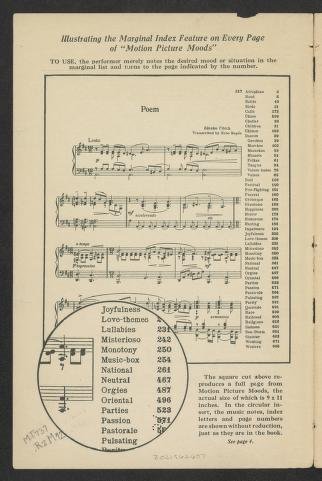No. 7 Andante Misterioso (A) For Stealthy, Ominous Scenes, Conspiracies etc.
I’m taking a fun class on the history of film music and it has introduced me to the story of “Cue Books”. Cue books were published for theater musicians playing along with silent movies. These were anthologies of bits of categorized mood music to be played for the scenes that would pop up on the screen.
Originally, silent films would be shown in storefront nickelodeons, and would maybe have just a piano player banging along as a tool to:
A) mask the sound of the projector or people shuffling about or “wrapping their f’n christmas presents” (as an old girlfriend of mine accused the people sitting next to us at the uptown theater of doing -thus ruining the whole experience for me)
and B) to try to guide people emotionally to keep them from laughing when someone is saying farewell to a lover departing on a train, or crying when a coconut hits someone on the head. But filmmakers learned early on that music really made the experience more immersive and fun and that the music could play while the reels were being changed or literal fires were being put out due to the film being highly flammable back then.
Fire!
As filmmakers wanted more control over how people experienced movies, a man named Max Winkler came up with the idea for a Cue Book. Thomas Edison had already started sending out the kinetogram, a list of appropriate pieces along with his movies to create some quality control as movie theaters starting opening up across the United States. Up until this time, at the early part of the twentieth century, every theater would have whatever musicians playing whatever quality instruments and whatever pieces or improvisations they could play to films they had never seen before. Edison sent his kinotogram newsletter to theaters playing his movies and it would list musical choices from the classical repertoire that could be played along with certain reels and certain scenes.
Max Winkler came up with an improved system of this that he called a Cue Book, Max Winkler worked in publishing at the Carl Fischer Music shop in New York, where silent film musicians would come in to buy sheet music to play. He came up with an idea to really create a scene-by-scene list of what to play depending on the movie and he knew he could sell more music if he included music from his store. His idea was to get a copy of the film, and then with a stopwatch he would time the films out to make music match the mood of each scene.
The Cue Sheet looked like this:
But my favorite thing from this period in the history of film music is the music anthologies or cue books that were published. These contained a selection of possible moods and the index would be printed on each page so you could quick jump from “love scene” to a “chase scene”, etc. Although they had started with bits of Beethoven or Grieg or other classical music, compilers and publishers of these anthologies started composing their own little incidental scene music to fit the mood.
The first anthology was published in 1909 and called:
“Motion Picture Piano Music: Descriptive Music to Fit the Actions, Character, or Scene of Moving Pictures”
There were many of these anthologies published over the following few years and their evolution culminated a vast encyclopedic volume by the conductor/composer Erno Rapees called Motion Picture Moods For Pianists and Organists. This vast volume contained 370 compositions and snippets shaped to scenes.
I picked up a fun compilation with bits from various historical anthology books called the Sounds for the Silents, and it is super fun to play some of the original melodies from the Sam Fox Moving Picture Music folio or the Remick Folio of Moving Picture Music.
I think I’ll sit down and play some “Mysterious Burglar Music” and then some “Paris Fashion Music” to create some fun moods for myself!
I’ll put some links below :)
If you want you can download Erno Rapees’ Motion Picture moods here ;)
Motion Picture Moods for Pianists and Organists
Heres a funny link to an old cartoon with a picture of it’s cue sheets







